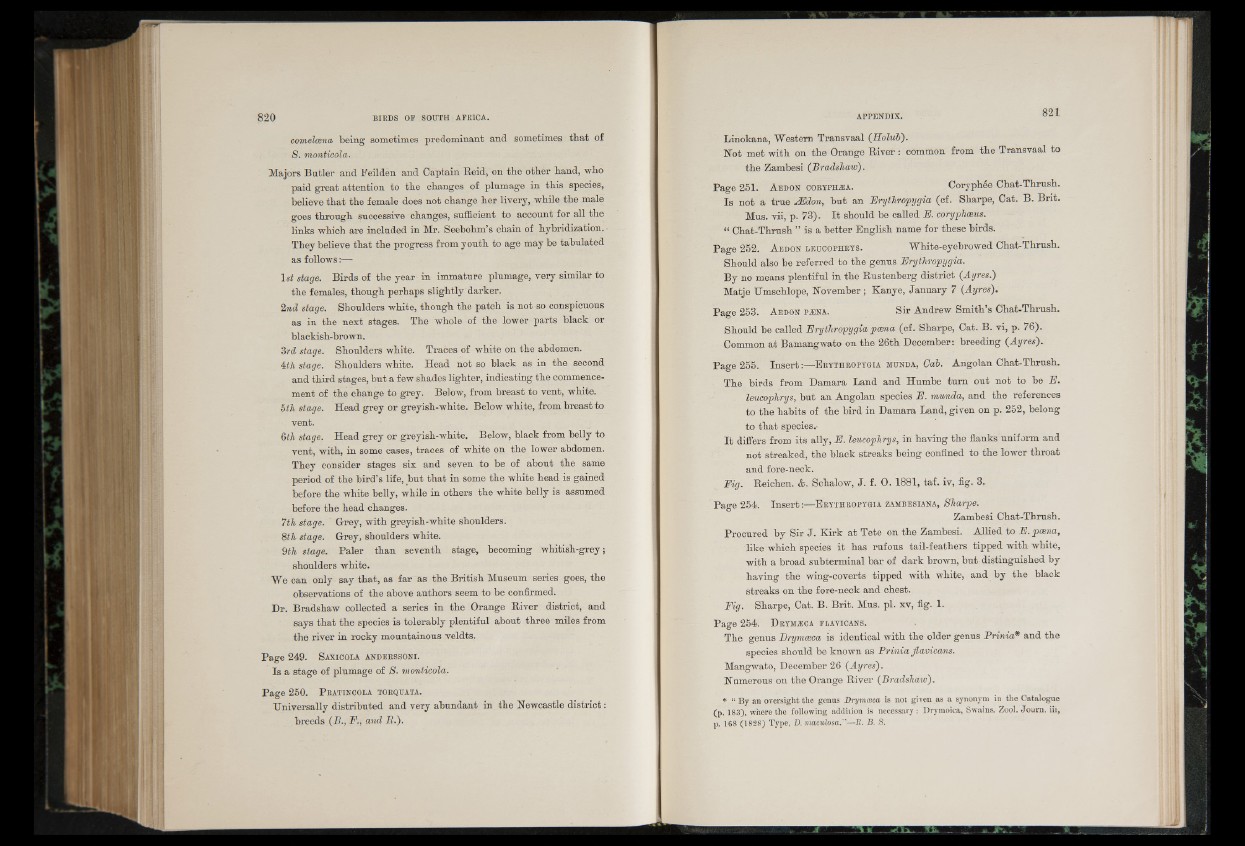
comelcma being sometimes predominant and sometimes th a t of
8. monticola.
Majors Butler and Eeilden and Captain Reid, on the other band, wbo
paid great attention to the changes of plumage in this species,
believe th a t the female does not change her livery, while the male
goes through successive changes, sufficient to account for all the
links which are included in Mr. Seebohm’s chain of hybridization. •
They believe that the progress from youth to age may be tabulated
as follows:—
1st stage. Birds of the year in immature plumage, very similar to
the females, though perhaps slightly darker.
2nd stage. Shoulders white, though the patch is not so conspicuous
as in the next stages. The whole of the lower parts black or
blackish-brown.
3rd stage. Shoulders white. Traces of white on the abdomen.
Atli stage. Shoulders white. Head not so black as in the second
and third stages, but a few shades lighter, indicating the commencement
of the change to grey. Below, from breast to vent, white.
5tin, stage. Head grey or greyish-white. Below white, from breast to
vent.
6th stage. Head grey or greyish-white. Below, black from belly to
vent, with, in some cases, traces of white on the lower abdomen.
They consider stages six and seven to be of about the same
period of the bird’s life, but th a t in some the white head is gained
before the white belly, while in others the white belly is assumed
before the head changes.
7th stage. Grey, with greyish-white shoulders.
8th stage. Grey, shoulders white.
9ffc stage. Paler than seventh stage, becoming whitish-grey;
shoulders white.
We can only say that, as far as the British Museum series goes, the
observations of the above authors seem to be confirmed.
Dr. Bradshaw collected a series in the Orange River district, and
says th a t the species is tolerably plentiful about three miles from
the river in rocky mountainous veldts.
Page 249. S a x ic o la a n d e r s s o n i.
Is a stage of plumage of S. monticola.
Page 250. P r a t i n c o l a t o r q u a t a .
Universally distributed and very abundant in the Newcastle d istric t:
breeds (B., F., and B-).
Linokana, Western Transvaal (Holub).
Not met with on the Orange River : common from the Transvaal to
the Zambesi (Bradshaw).
Page 251. A e d o n c o ry p hæ a . Coryphée Chat-Thrush.
Is not a true Ædon, but an Frythropygia (cf. Sharpe, Cat. B. Brit.
Mus. vii, p. 73). I t should be called F. coryphaeus.
“ Chat-Thrush ” is a better English name for these birds.
Page 252. A e d o n l e u c o p h r y s . White-eyebrowed Chat-Thrush.
Should also be referred to the genus Frythropygia.
By no means plentiful in the Rustenberg district (Ayres.)
Matje Umschlope, November ; Kanye, January 7 (Ayres).
Page 253. A e d o n pæna. Sir Andrew Smith’s Chat-Thrush.
Should be called Frythropygia poena (cf. Sharpe, Cat. B. vi, p. 76).
Common at Bamangwato on the 26th December: breeding (Ayres).
Page 255. Insert :—E r y th r o p y g i a m u n d a, Gab. Angolan Chat-Thrush.
The birds from Damara Land and Humbe turn out not to be F.
leucophrys, but an Angolan species F. munda, and the references
to the habits of the bird in Damara Land, given on p. 252, belong
to th a t species.-
I t differs from its ally, F. leucophrys, in having the flanks uniform and
not streaked, the black streaks being confined to the lower throat
and fore-neck.
Fig. Reichen. &. Schalow, J. f. 0.1881, taf. iv, fig. 3.
Page 254. Insert :—E r y th r o p y g i a z am b e s ian a , Sharpe.
Zambesi Chat-Thrush.
Procured by Sir J. Kirk at Tete on the Zambesi. Allied to F. poena,
like which species it has rufous tail-feathers tipped with white,
with a broad sub terminal bar of dark brown, but distinguished by
having the wing-coverts tipped with white, and by the black
streaks on the fore-neck and chest.
Fig. Sharpe, Cat. B. Brit. Mus. pi. xv, fig. 1.
Page 254. D rym æ c a f l a v i c a n s .
The genus Frymceca is identical with the older genus Prinia* and the
species should be known as Prinia flavicans.
Mangwato, December 26 (Ayres).
Numerous on the Orange River (Bradshaw).
* “ By an oversight the genus Drymæca, is not given as a synonym in the Catalogue
(p. 183), where the following addition is necessary : Drymoiea, Swains. Zool. Joum. iii,
p. 168 (1828) Type, D. maculosa.''-—R. B. S.